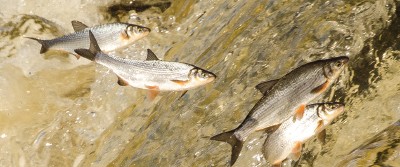Modern Dams Thwart Ancient Instincts

By Mike Howie
In the fall, salmon follow their instincts out of the ocean and upriver to their breeding grounds, a safe place for their eggs to hatch and their babies to mature. Historically, very little could stop them from getting there. They would jump over small waterfalls, avoid hungry bears, and evade the hooks of fishermen while chasing the inescapable need to reproduce. But no salmon can jump over a dam.
River Blocks
Humans build dams for any number of reasons. Some help prevent floods, some collect water for irrigation, and others generate electricity. All of them, however, get in the way of migrating fish. When the salmon run into a dam before they reach their breeding grounds, they don’t know what to do. They pool at the bottom and swim around, stuck between human creations and natural instincts.
On the other side of the dam, another story is unfolding. Sediment that the river would normally carry to the ocean becomes trapped behind the dam, just like the salmon. In an unimpeded river that sediment would become a sandy beach, but behind a dam it’s just mud.
Breaking Barriers
Luckily for sand and salmon, a few environmental restoration projects are showing just how disruptive dams can be. When the Elwha and Glines Canyon dams were removed from the Elwha River in Washington State’s Olympic National Park, salmon and other migrating fish responded quickly, making their way to breeding grounds they hadn’t visited for over a hundred years.
That part was to be expected, but the sand is what excited the scientists who studied the project. They estimated that millions of tons of sediment had piled up behind the dams, and once they came down that sediment was free to flow toward the ocean and accumulate in the river delta. About 2.5 million cubic yards of sediment settled in the river delta in the first two years after the dams were gone, followed by another 1.5 million cubic yards over the next few years.
After a decade or so the river will return to its normal patterns, with about 300,000 cubic yards of sediment flowing down the river each year. Sand will go to the beach, salmon will lay their eggs, and nature will be in control once again.
DISCUSSION QUESTIONS
What negative effects could result from the removal of a dam?
Research the causes and effects of beach erosion, then discuss solutions for improving and managing it.
VOCABULARY
- River Delta
- Sediment
- Spawn
